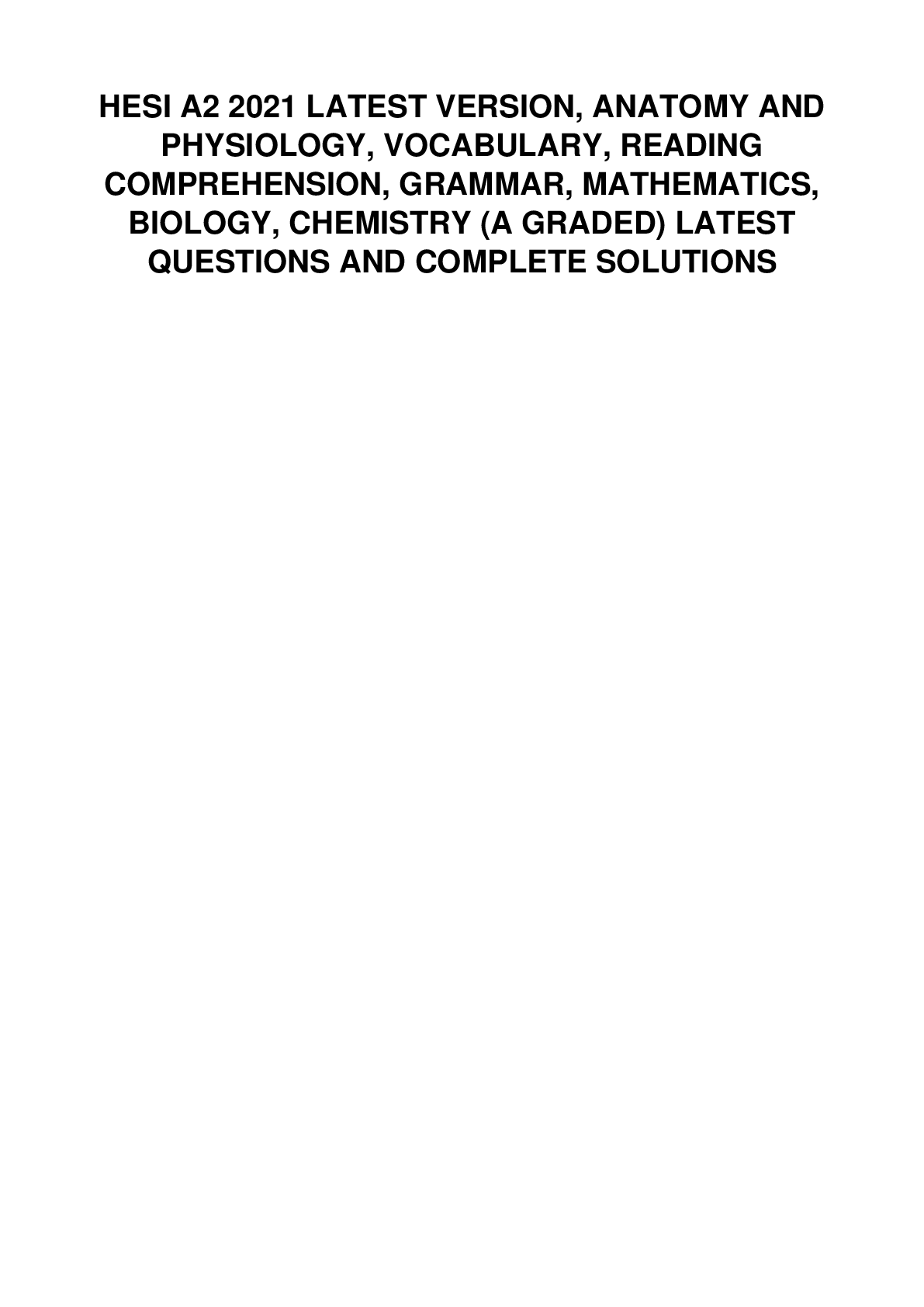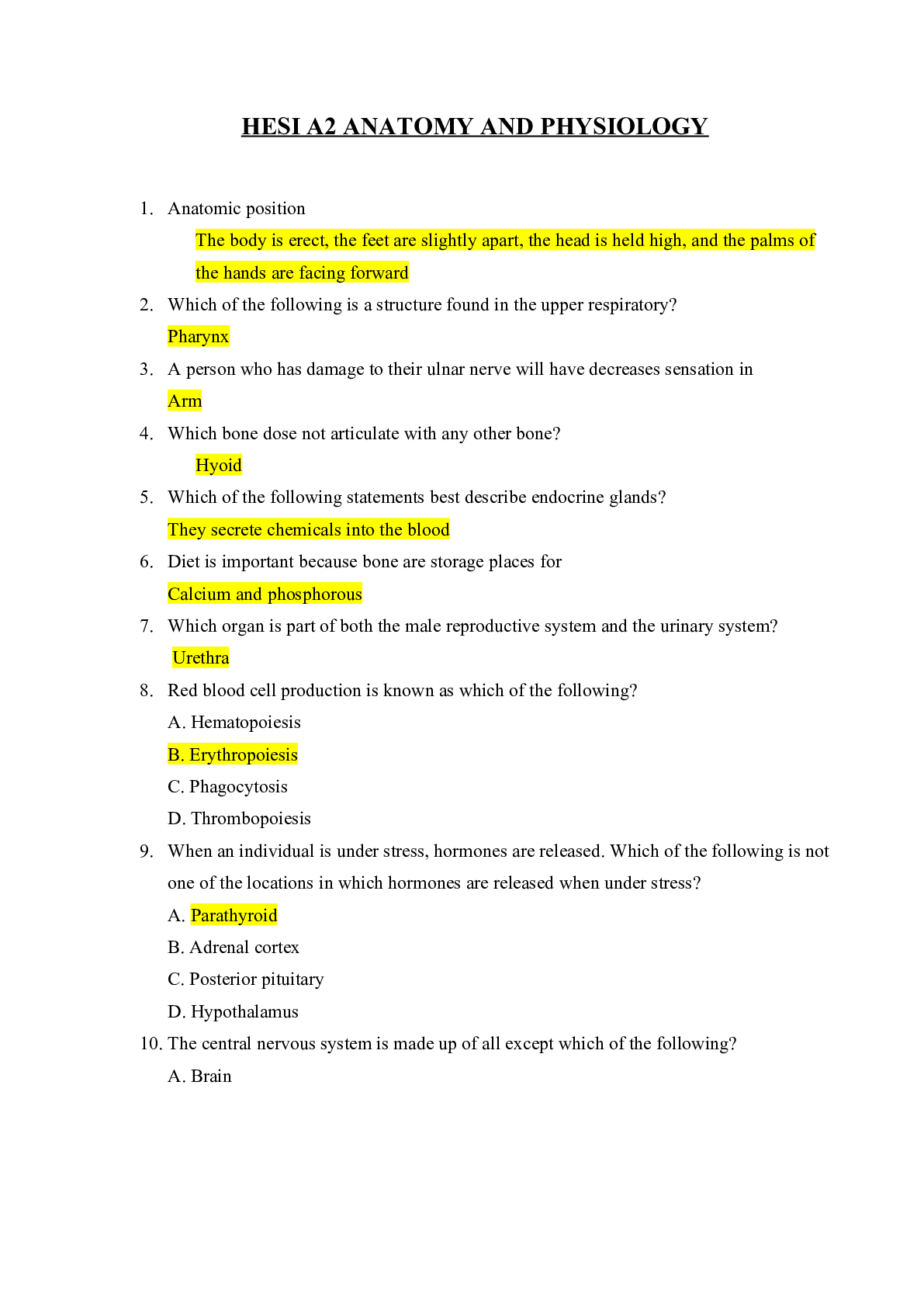HESI A2 Anatomy and Physiology 2021/2022 Answered.
Document Content and Description Below
HESI A2 A&P: 2021/2022 Which is an anterior muscle? A. Gluteus maximus B. Quadriceps femoris C. Biceps femoris D. Adductor magnus How might the headrest on a car prevent traumatic injury? ... A. By limiting hyperflexion of the neck B. By limiting hyperextension of the neck C. By reducing vertebral compression D. By preventing disc degeneration Which might you expect to see in a whiplash injury? A. Cardiopulmonary problems B. Side-to-side spinal curvature C. Eventual herniation of discs D. Traumatic injury to ligaments Muscle contractions that normally move food along the human digestive system are known as ________. A. defecation B. osmosis C. peristalsis D. circulation Which type of nutrient does not provide the body with energy? A. Vitamin B. Carbohydrate C. Fat D. Protein Where would you be likely to find a Schwann cell? A. In the digestive system B. In the nervous system C. In the skeletal system D. In the muscular system How does the nervous system work with the muscular system? A. The muscles of the body produce chemicals that feed the nerves. B. The nervous system tells the muscles how to respond to the environment. C. The nervous system releases chemicals that remove excess waste from the muscles. D. The muscular system provides input that allows the nerves to make decisions. Which part of the nervous system includes the femoral , radial, and ulnar nerves? A. Somatic B. Autonomic C. Sympathetic D. Parasympathetic Where might a herniated lumbar disc be most likely to create pain? A. Along the radial nerve B. Within the spinal cord C. Along the sciatic nerve D. Along the tibial nerve What is the name of the bone in the human thigh? A. Ulna B. Femur C. Radius D. Humerus The ovaries are part of the ___________. A. skeletal system B. nervous system C. lymphatic system D. reproductive system Of the following processes, which one is a different level of defense from the others? A. A low pH in the stomach B. Cilia present in the trachea C. Body cells recognizing a pathogen D. Mucus present in the nasal cavity Which organ system is primarily responsible for regulating muscle growth? A. The skeletal system B. The endocrine system C. The nervous system D. The reproductive system Which parts of the heart are separated by the mitral valve? A. Left atrium and right atrium B. Right atrium and right extremities C. Left ventricle and right ventricle D. Left atrium and left ventricle How might vitamin D deficiency present? A. As bleeding gums B. As swollen extremities C. As red patches D. As crooked bones How does the lymphatic system work with the circulatory system? A. The circulatory system produces red blood cells for the lymphatic system. B. Lymph draws excess fluid from the cells and deposits it into the blood vessels. C. The heart regulates the production of lymph in the lymph glands. D. White cells from the lymphatic system eliminate excess red blood cells. What is the function of parathyroid hormone? A. Increasing energy levels B. Stimulating cell reproduction C. Speeding up metabolism D. Activating vitamin D Which feature of the ear is most medial? A. Pinna B. Tympanic membrane C. Cochlea D. Outer canal Which of the following are considered normal values for the measure of a person's pulse and blood pressure? A. 55 beats per minute and 75 over 60 mm Hg B. 72 beats per minute and 120 over 80 mm Hg C. 100 beats per minute and 140 over 100 mm Hg D. 160 beats per minute and 100 over 70 mm Hg How does a sagittal section divide the body? A. Into right and left regions B. Into upper and lower regions C. Into front and back regions D. Between the dorsal and ventral cavities How is pepsin used by the body? A. To break down proteins B. To break down starches C. To emulsify fats and oils D. To absorb water and nutrients The esophagus is part of the __________ A. endocrine system B. digestive system C. respiratory system D. nervous system Which mineral supports the function of the thyroid? A. Manganese B. Iodine C. Phosphorus D. Zinc The cheekbones are _________ to the nose. A. anterior B. proximal C. deep D. lateral Which organ system is primarily responsible for generating antibodies? A. The endocrine system B. The digestive system C. The lymphatic system D. The nervous system The lateral side of the right knee would be ______. A. the kneecap. B. closest to the left knee. C. farthest from the left knee. D. on the underside of the knee. In which part of the lungs do nearly all the gaseous exchanges between air and blood take place? A. Pleura. B. Trachea. C. Bronchioles. D. Alveoli. How do the intercostal muscles between the ribs assist with respiration? A. By protecting the delicate bronchioles and alveoli. B. By signaling a decrease in intra-alveolar pressure. C. By enlarging and reducing the space in the thorax. D. By maintaining a medial separation between pleurae. In which organ do muscles push food into the stomach via peristalsis? A. Mouth. B. Small intestine. C. Epiglottis. D. Esophagus. For the average person, what is true about caloric intake? A. It should increase with age after age 25. B. It should decline with age after age 25. C. It should remain constant over a lifetime. D. It should decline and then increase with age. The corpus callosum facilitates communication between _________. A. the left and right brain. B. the skeletal and neural systems. C. the brain and spinal cord. D. the thalamus and hypothalamus. How does the integumentary system work with the nervous system? A. The integumentary system removes heat from the neurons in the nervous system. B. The nervous system circulates nutrients outward to the integumentary system. C. Touch input via the integumentary system sends messages to the nervous system. D. Messages from the nervous system affect the color and texture of the skin. When the pulmonary valve and aortic valves are open, where can blood flow? A. Between the two ventricles of the heart. B. From atrium to ventricle within the heart. C. Between the heart and the rest of the body. D. Between the atria in the heart. Which might be a result of stenosis, or narrowing of a heart valve? A. Abdominal pain. B. Blood clots. C. Edema (swelling) in organs. D. Irregular heartbeat. The human skull contains about how many bones? A. about 5. B. about 30. C. about 60. D. about 210. At birth we have 44separate bony structures in our skulls, but many of those fuse as we age. The arteries are part of the ___________. A. nervous system. B. endocrine system. C. lymphatic system. D. cardiovascular system. Which is a secondary defense for the body against pathogens? A. Tears. B. Urine. C. Inflammation. D. Mucus. Which organ system is primary responsible for storing minerals? A. The skeleral system. B. The endocrine system. C. The lymphatic system. D. The cardiovascular system. The vena cavae drain blood from the body into the _______. A. right atrium. B. right ventricle. C. left atrium. D. left ventricle. Beriberi is a disease caused by lack of __________. A. thiamine. B. vitamin C. C. niacin. D. protein. How does the endocrine system work with the reproductive system? A. The reproductive system transforms minerals into useful nutrients. B. The endocrine system determines the sex of the embryo. C. The reproductive system controls the growth of secondary sex organs. D. The endocrine system produces chemicals that regulate sexual function. Which hormone controls sleep, mood, and appetite? A. Serotonin. B. Oxytocin. C. Cortisol. D. Aldosterone. Which part of the brain is most posterior? A. Frontal lobe. B. Parietal lobe. C. Temporal lobe. D. Occipital lobe. Which of the following is an HDL cholesterol level that might warrant regular testing? A. 70. B. 60. C. 50. D. 40. How does a transverse section divide the body? A. Into right and left regions. B. Into upper and lower regions. C. Into front and back regions. D. Between the dorsal and ventral cavities. What is the function of amylase? A. Breaking down starch. B. Digesting fat. C. Breaking down protein. D. Absorbing water. The spleen is part of the ___________. A. nervous system. B. integumentary system. C. lymphatic system. D. urinary system. Which minaral is important for the formation of red blood cells? A. Selenium. B. Calcium. C. Magnesium. D. Copper. The dorsal body cavity is _________ to the ventral body cavity. A. medial. B. deep. C. posterior. D. anterior. Which organ system is primarily responsible for preventing water loss? A. The nervous system. B. The integumentary system. C. The lymphatic system. D. The urinary system. Which is an anterior feature of the human head? A. The nose. B. The ears. C. The occipital lobe. D. The temporal lobe. What is the primary hormone secreted by the thyroid? A. Oxytocin. B. TSH. C. Adrenaline. D. T4. Enlargement of the thyroid, commonly known as a goiter, might be expected to affect ________. A swallowing. B. insulin levels. C. sleep. D. digestion. Which kinds of muscles are involved in peristalsis? A. Smooth muscles. B. Cardiac muscles. C. Skeletal muscles. D. Epaxial muscles. Why might certain young people be underweight? A. They are growing in height faster than they are gaining weight. B. They eat little protein and too much fat and suger. C. They eat several meals a day and fail to exercise enough. D. They seldom eat a meal that contains foods from all food groups. What might an injury to the parietal lobe affect? A. Breathing. B. Attention. C. Memory. D. Perception How does the digestive system work with the urinary system? A. The digestive system controls the function of the ureter. B. The urinary system removes toxins from the products of digestion. C. The digestive system manufactures hormones that influence urination. D. The urinary system eliminates some waste products of digestion. Which gland is located superior to the kidney? A. Pituitary. B. Adrenal. C. Hypothalamus. D. Pncreas. To what two systems might the urethra belong? A. Reproductive and endocrine. B. Urinary and reproductive. C. Endocrine and urinary. D. Digestive and cardiovascular. The axial skeletal system contains all of these except ________. A. the skull. B. the ribs. C. the breastbone. D. the radius. The gall bladder is part of the __________. A. endocrine system. B. urinary system. C. digestive system. D. nervous system. Which is Not an example of a nonspecific immune response? A. Inflammation. B. Vasodilation. C. Releases of histamine. D. Production of antibodies Which organ system is primarily responsible for regulating electrolytes? A. The endocrine system. B. The urinary system. C. The lymphatic system. D. The nervous system What is the function of the coronary artery? A. It carries oxygenated blood to the heart. B. It carries deoxygenated blood to the lungs. C. It distributes blood to the body. D. It supplies blood to the heart muscle. What condition might result from lack of vitamin C? A. Kwashiorkor. B. Pellagra. C. Rickets D. Scurvy How does the muscular system work with the skeletal system? A. Muscles attached to tendons contract to bend the skeleton at the joints. B. The hard bones of the skeleton protect the voluntary muscles of the limbs. C. The cardiac muscles produce calcium that is needed for sturdy bones. D. Smooth muscles on internal organs leach excess minerals from the bones. Messages from the nervous system tell the muscles to contract, which in turn moves the bones. Which is Not produced by the pituitary gland? A. FSH B. TRH C. LH D. ADH The ribs are ________ to the lungs in the human body. A. medial B. superior C. anterior D. deep The ribs are in front of the lungs in the human body, making them closer to the front of the body, or anterior. What is the normal pH of human arterial blood? A. 6.8 B. 7.4 C. 7.9 D. 8.2 Which cut is considered a cross section? A. A sagittal or frontal section. B. A cut along the coronal plane. C. A cut along the median plane. D. A cut through the transverse plane. A transverse section is a cross section; it separates the body horizontally into upper and lower sections. Which enzyme functions to break down a specific sugar? A. Catalase. B. Lipase. C. Protease. D. Lactase. Lactase breaks down lactose into simpler sugars. The hypothalamus is part of the _________. A. cardiovascular system. B. endocrine system. C. respiratory system. D. lymphatic system. The hypothalamus regulates the body's internal balance, or homeostasis. It also controls the pituitary gland and links the endocrine system to the nervous system. Which minaral helps to maintain fluid balance in the body? A. Potassium. B. Cobalt. C. Chromium. D. Sulfur. Fluid balance is connected to electrolyte balance. The key electrolytes in the human body include sodium, potassium, calcium, chloride, and bicarbonate. The skull is _________ to the spinal cord. A. anterior. B. posterior. C. lateral. D. superior. The skull sits atop the spinal cord, making it superior in position. Which organ system is primarily responsible for integrating voluntary movements? A. Cardiovascular system. B. Digestive system. C. Respiratory system. D. Nervous system. The nervous system controls the voluntary movements of the skeletal system. What mineral is responsible for muscle contractions? A. Chloride. B. Sodium. C. Calcium. D. Magnesium. In which of the following locations would the urinary bladder and internal reproductive organs be found? A. Thoracic cavity. B. Mediastinum. C. Abdominal cavity. D. Pelvic cavity. What separates the thoracic cavity from the abdominal cavity? A. Diaphragm. B. Mediastinum. C. Liver. D. Lungs. Which of the following epithelial types is correctly matched with its major function? A. Simple squamous epithelium - secretion or absorption. B. Stratified squamous epithelium - changes shape when stretched. C. Stratified squamous epithelium - diffusion. D. Simple columnar epithelium - secretion or absorption. A tissue examined under the microscope exhibits the following characteristics: cells found on internal surface of stomach, no extracellular matrix, cells tall and thin, no blood vessels in the tissue. What type of tissue is this? A. Epithelial. B. Connective. C. Muscle. D. Nervous. Nerve tissue is composed of neurons and connective tissue cells that are referred to as which of the following? A. Osteoblasts. B. Neuroglia. C. Osteocytes. D. Arterioles. Which tissue serves as the framework of the body by providing support and structure for the organs? A. Epithelial. B. Connective. C. Nervous. D. Muscle. What is the basic unit of life and the building block of tissues and organs? A. Atom. B. Organelle. C. Cell. D. DNA. Which type of cell division takes place in the gonads? A. Mitosis. B. Meiosis. C. Binary fission. D. Asexual division. In what area of the body would you expect to find an especially thick stratum corneum? A. Back of the hand. B. Heel of the foot. C. Abdomen. D. Over the shin. What are the glands of skin that produce a thin, watery secretion? A. Sebaceous glands. B. Eccrine glands. C. Apocrine glands. D. Endocrine glands. Skin aids in maintaining the calcium and phsphate levels of the body by participating in the production of which of the following? A. Sebum. B. Keratin. C. Vitamin A. D. Vitamin D. Which of the following are functions of the skeletal system? (select all that apply.) A. Support the body. B. Hemopoiesis. C. Conduct impulses. D. Provide protection. B. D. The orthopedic surgeon informs you that you have broken the middle region of the humerus. What is he describing? A. Epiphysis. B. Articular cartilage. C. Perichondrium. D. Diaphysis. You have been given sample of tissue that has open spaces partially filled by an assemblage of needlelike structures. What is the tissue? A. Spongy bone. B. Compact bone. C. Cartilage. D. Adipose tissue. Which of the following bones is the only moveable bone of the skull? A. Maxilla. B. Zygomatic. C. Lacrimal. D. Mandible. Which mineral is responsible for regulating fluid in the body? A. Chloride. B. Sodium. C. Calcium. D. Magnesium. Why are skeletal muscles also called voluntary musckes? A. They are under conscious control. B. They are attached to the skeleton. C. They are ATP to energize contraction. D. They are striated in appearance. All actions of the nervous system depend on the transmission of nerve impulses over which of the following? A. Neuroglia. B. Efferent pathways. C. Afferent pathways. D. Neurons. Motor or _______ neurons transmit nerve impulses away from the CNS. A. Afferent B. Efferent. C. Central. D. Peripheral. Jeffery has contracted bulbar poliomyelitis, and it has affected the medulla oblongata. The doctors warned the family that his condition is grave and death may be imminent. What functions of the medulla oblongata have warranted such a dire prognosis? A. The medulla oblongata contains vital centers that control heart action, blood vessel diameter, and respiration. B. The medulla oblongata contains neural connections of the reticular-activating system. C. The medulla oblongata contains the pineal gland, which controls the vital centers. D. The medulla oblongata contains the corpora quadrigemina, which controls the neural transmission of impulses along the spinal cord. What are chemical messengers that control growth, differentiation, and the metabolism of specific target cells called? A. Hormones. B. Neurons. C. Glands. D. Second messengers. Which of the following are tropic hormones? (select all that apply.) A. Somatotropin. B. Follicle-stimulating hormone. C. Antidiuretic hormone. D. Thyroid-stimulating hormone. Which leukocytes are correctly matched with their function or description? (select all that apply.) A. Monocytes - become macrophages. B. Basophils - the most common type of WBC. C. Lymphocytes - important in immune response. D. Neutrophils - phagocytize. The heart has an intrinsic beat that is initiated by which of the following? A. Semilunar valve. B. Bicuspid valve. C. Tricuspid valve. D. Sinoatrial node. Vasodilation and vasoconstriction result from which of the following? A. Contraction of smooth muscle in the arterial wall. B. Relaxation of smooth muscle in the arterial wall. C. Relaxation and contraction of smooth muscle in the arterial wall. D. Contraction and relaxation of smooth muscle in the venous wall. Which of the following is the blood vessel where exchanges take place between blood and the cells of the body? A. Artery. B. Vein. C. Capillary. D. Arteriole. What is the exchange of gases between the atmosphere and the blood through the alveoli called? A. External respiration. B. Internal respiration. C. Inhalation. D. Cellular respiration. In order for inhalation to occur, what must happen? A. Contraction of the diaphragm, which decreases the volume of the chest cavity and draws air into the lungs. B. Contraction of the diaphragm, which enlarges the chest cavity and draws air into the lungs. C. Recoil of the lungs as the respiratory muscles contract, and the thorax decreases in size. D. Recoil of the lungs as the respiratory muscles relax, and the thorax decreases in size. Most of the carbon dioxide in the blood does which of the following? A. It is carried in solution or bound to blood proteins. B. It is carried on hemoglobin. C. It is converted to bicarbonate ions by carbonic anhydrase within red blood cells. D. It is converted to bicarbonate ions by carbonic anhydrase within the plasma. How does the trachea remain open like a hollow tube? A. Air pressure inside keeps it open. B. Supporting cartilaginous rings keep it open. C. It is reinforced with bone that cannot collapse. D. Special muscles are working to keep the trachea open. The stomach muscle churns and mixes food, turning the mass into a soupy substance called which of the following? A. Bolus. B. Bile. C. Chyme. D. Feces. What is the function of aldosterone? A. It converts proinsulin to insulin. B. It conserves sodium in the body. C. It protects against stress. D. It affects heat production. All the nutrients that enter the hepatic portal vein are routed where for decontamination? A. Kidney. B. Pancreas. C. Spleen. D. Liver. Which are the functional units of the kidney? A. Ureters. B. Glomeruli. C. Nephrons. D. Renal capsules. What are the two functions of the male and female sex organs? A. Production of all cells and production of hormones. B. Production of interstitial cells and production of hormones. C. Production of gametes and production of hormones. D. Production of gametes and production of interstitial cells. In men, spermatozoa develop within the ________ of each testis. A. Seminiferous tubules. B. Vas deferens. C. Ejaculatory ducts. D. Bulbourethral glangs. Testicular activity is under the control of which hormone(s)? A. FSH B. LH C. GH D. Both FSH and LH Which hormone initiates the preparation of the endometrium of the uterus for pregnancy? A. FSH B. Estrogen C. LH D. During pregnancy, what organ produces the hormones that maintain the endometrium and prepare the breasts for milk production? A. Placenta. B. Uterus. C. Cervix. D. Corpus luteum. [Show More]
Last updated: 1 year ago
Preview 1 out of 19 pages
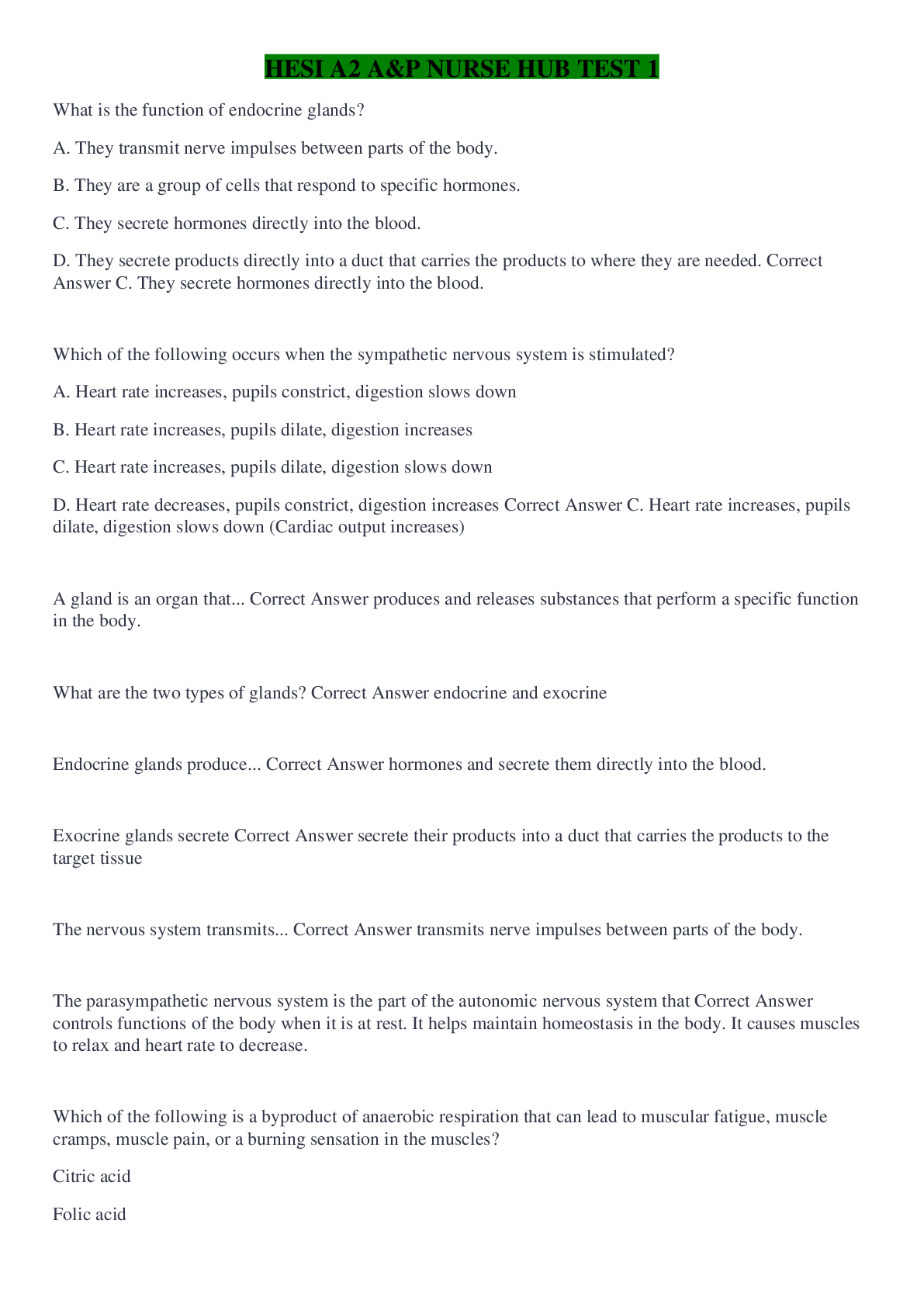
Reviews( 0 )
Document information
Connected school, study & course
About the document
Uploaded On
Mar 12, 2022
Number of pages
19
Written in
Additional information
This document has been written for:
Uploaded
Mar 12, 2022
Downloads
0
Views
119

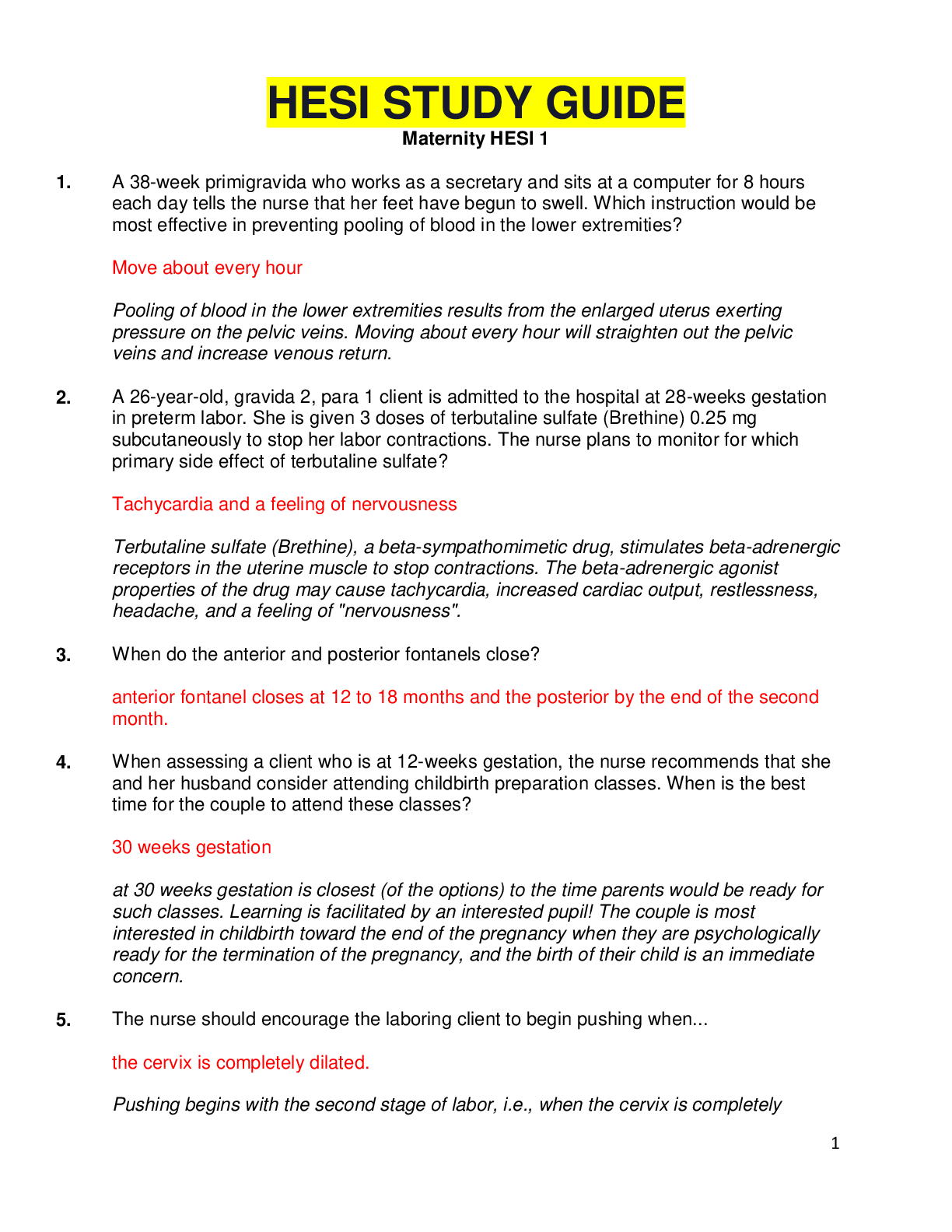
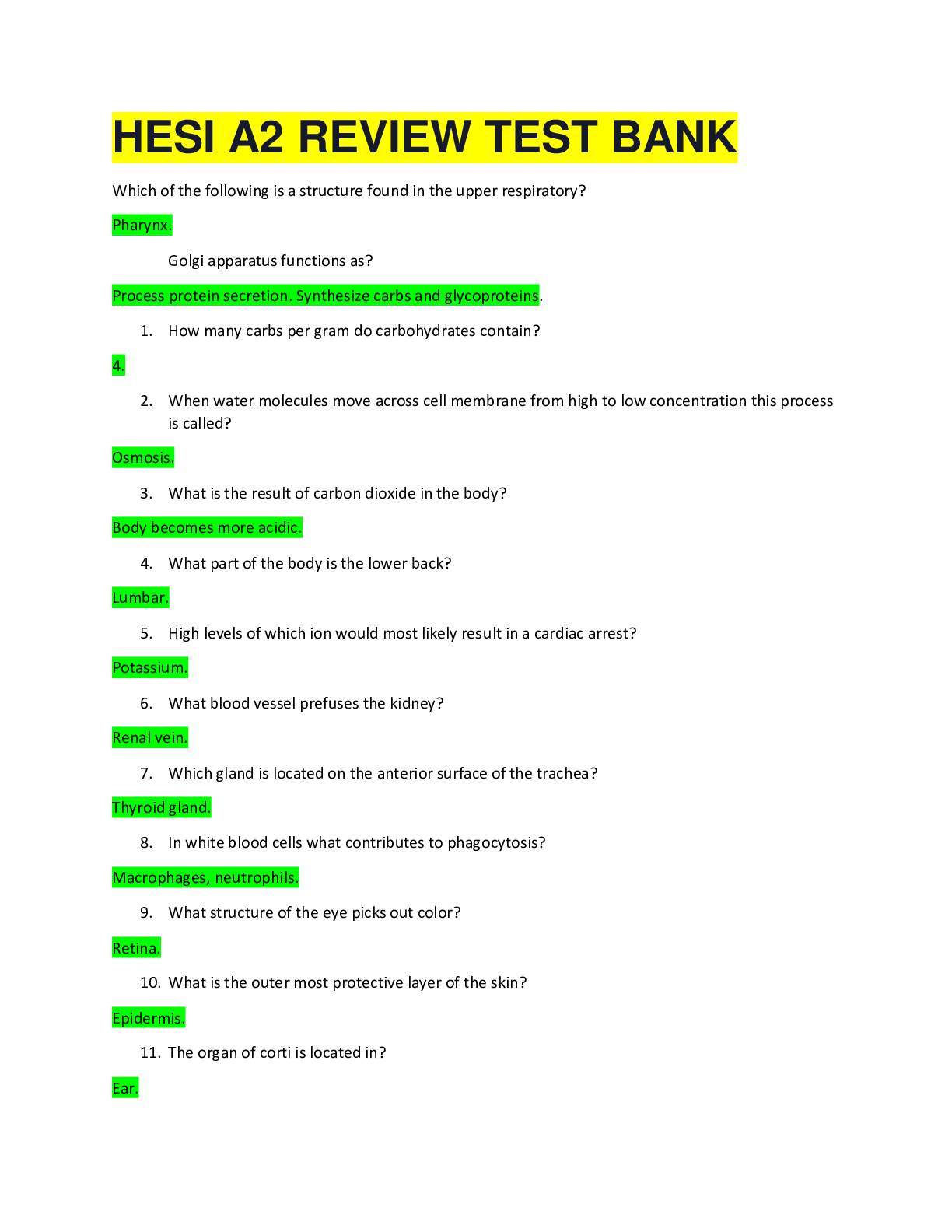
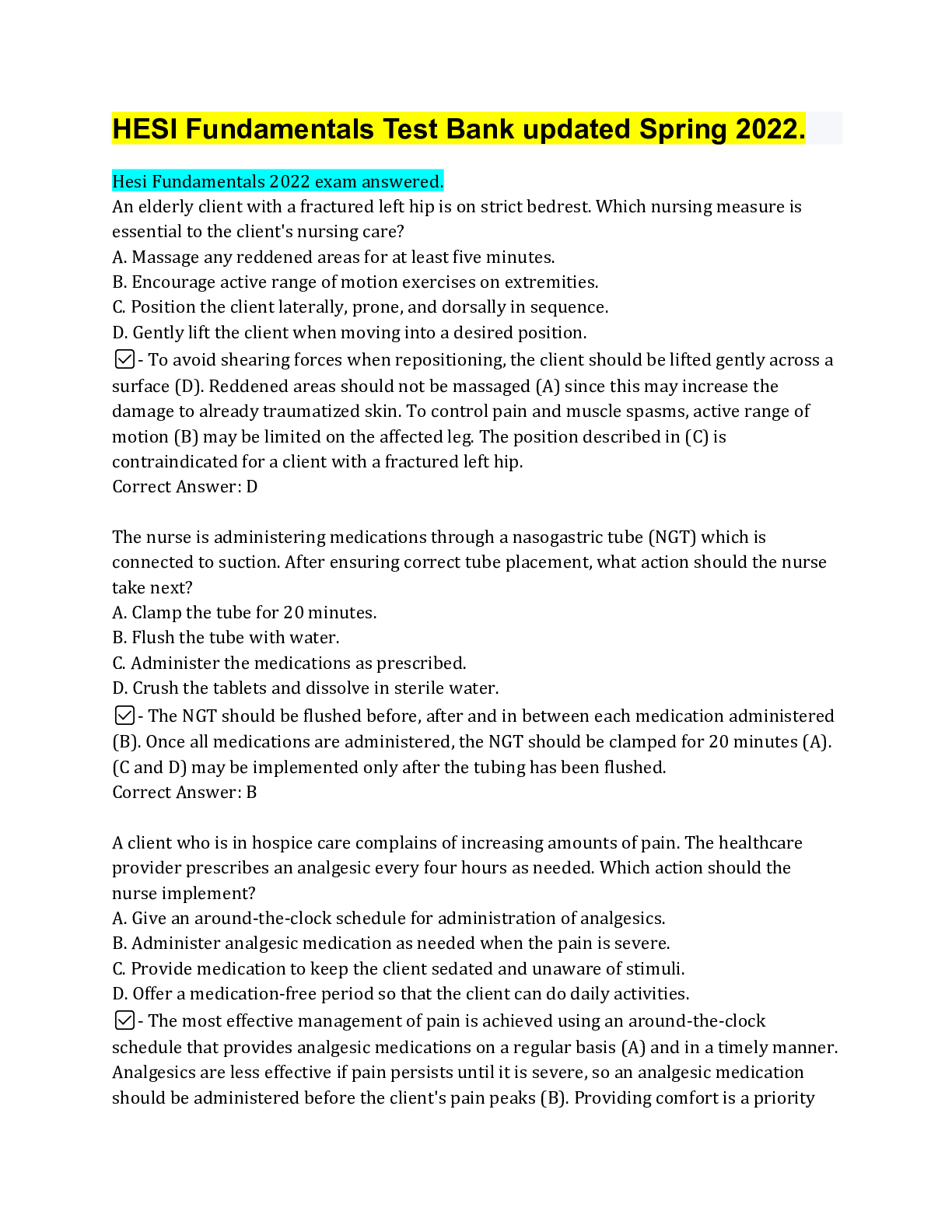
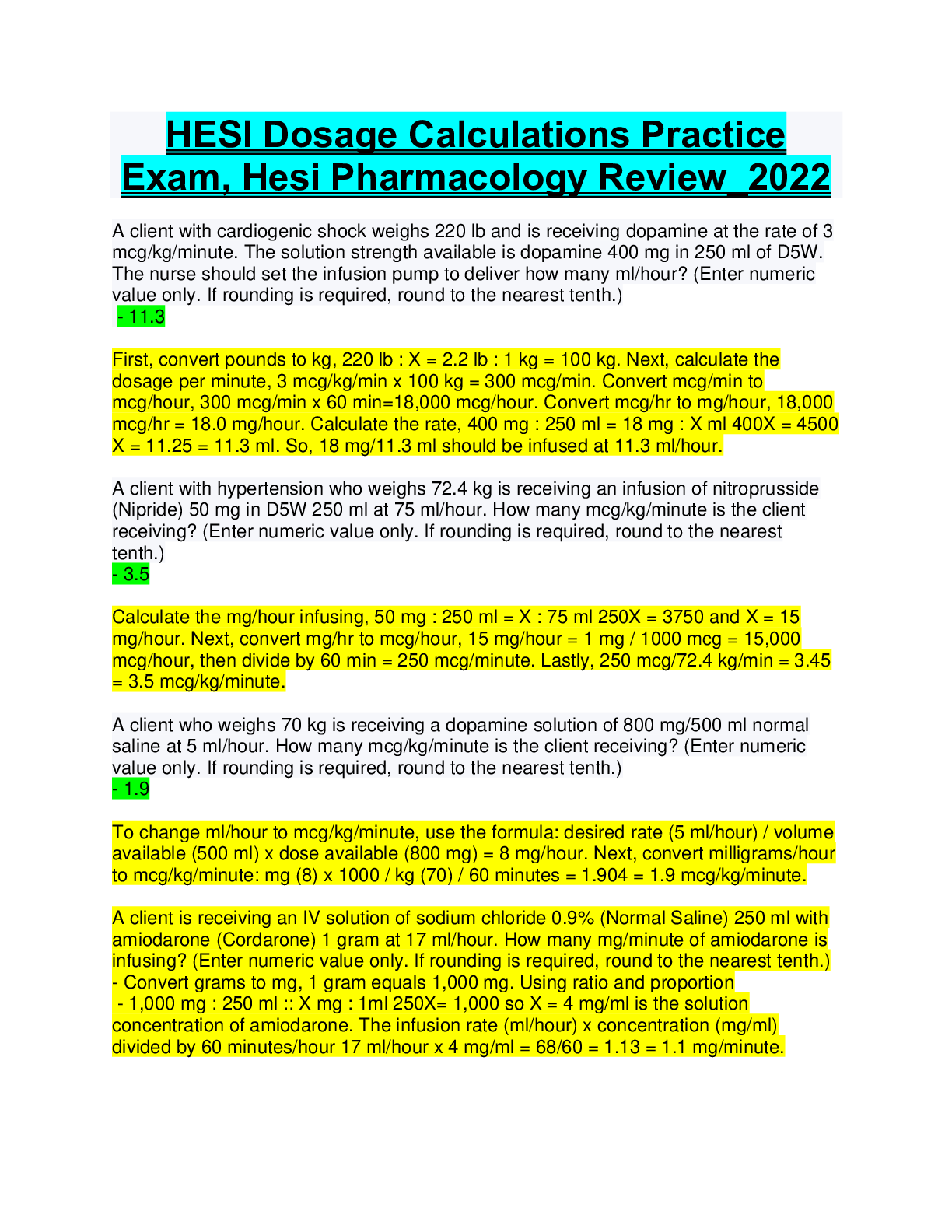
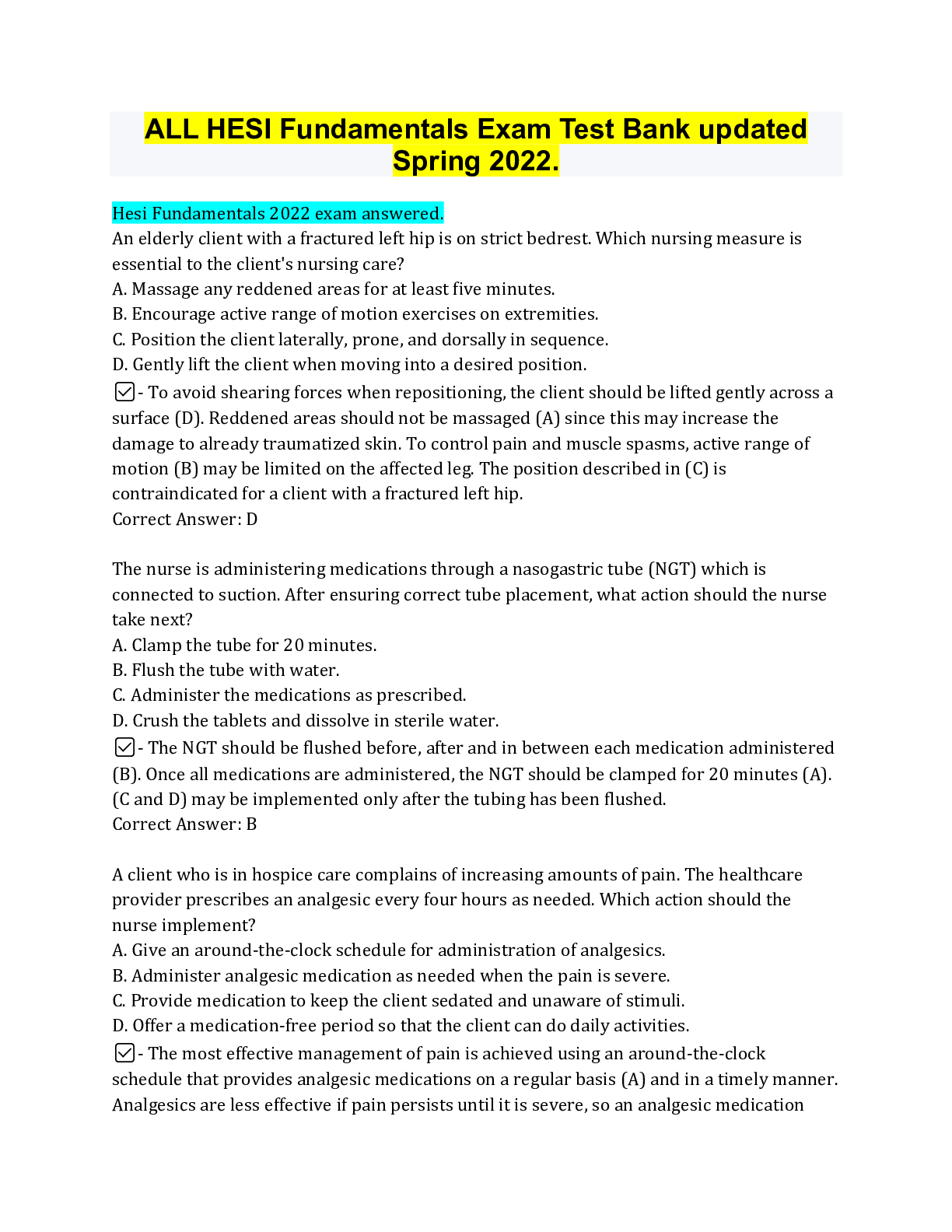
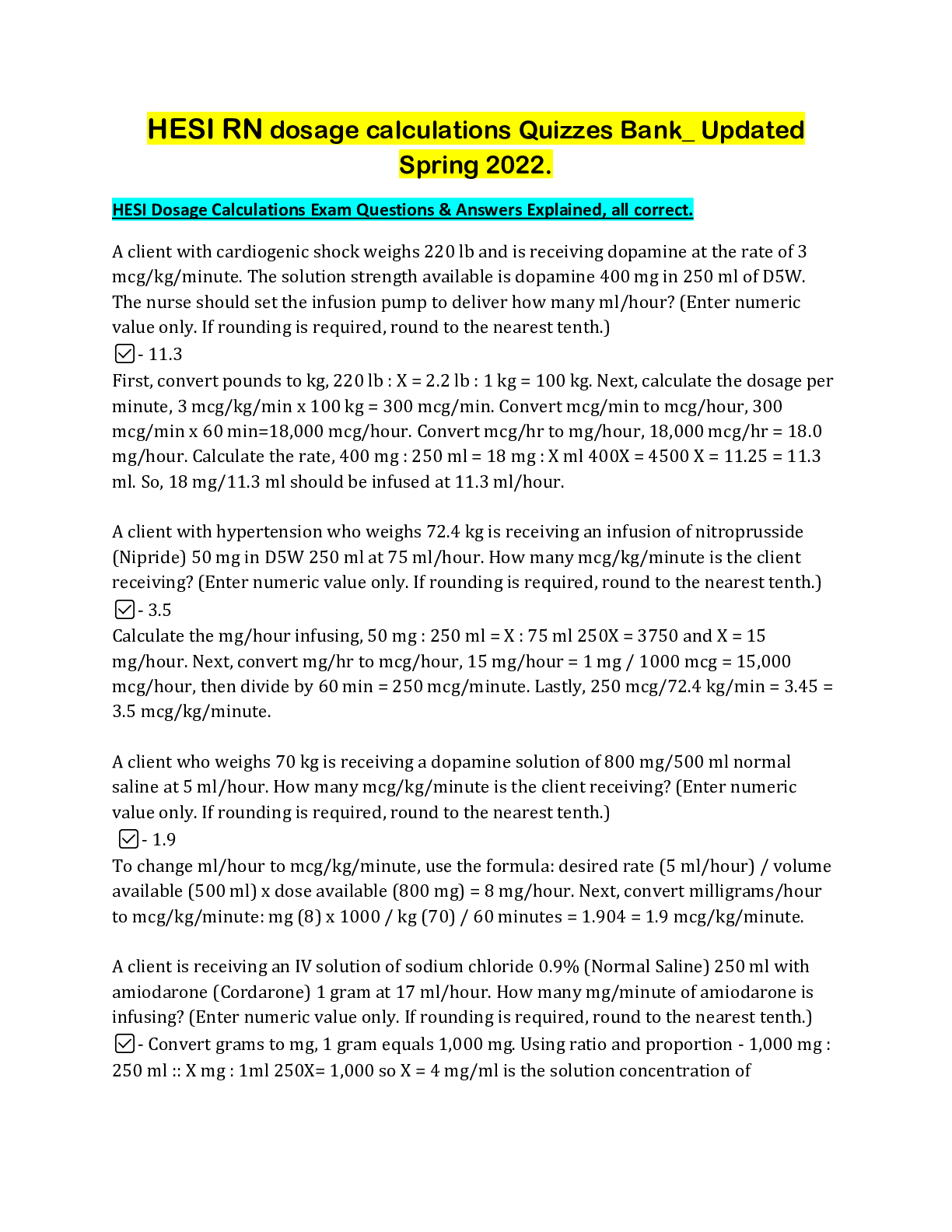

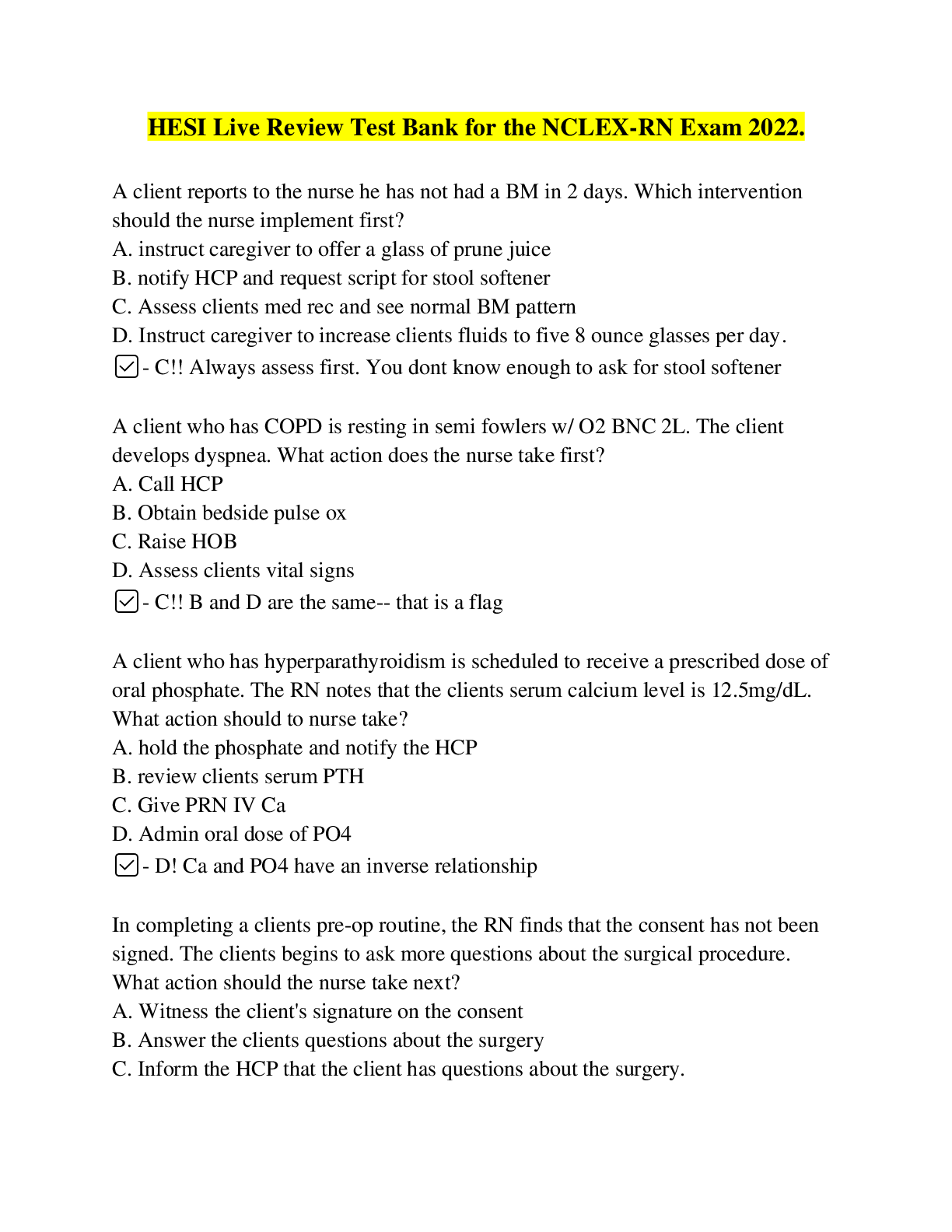
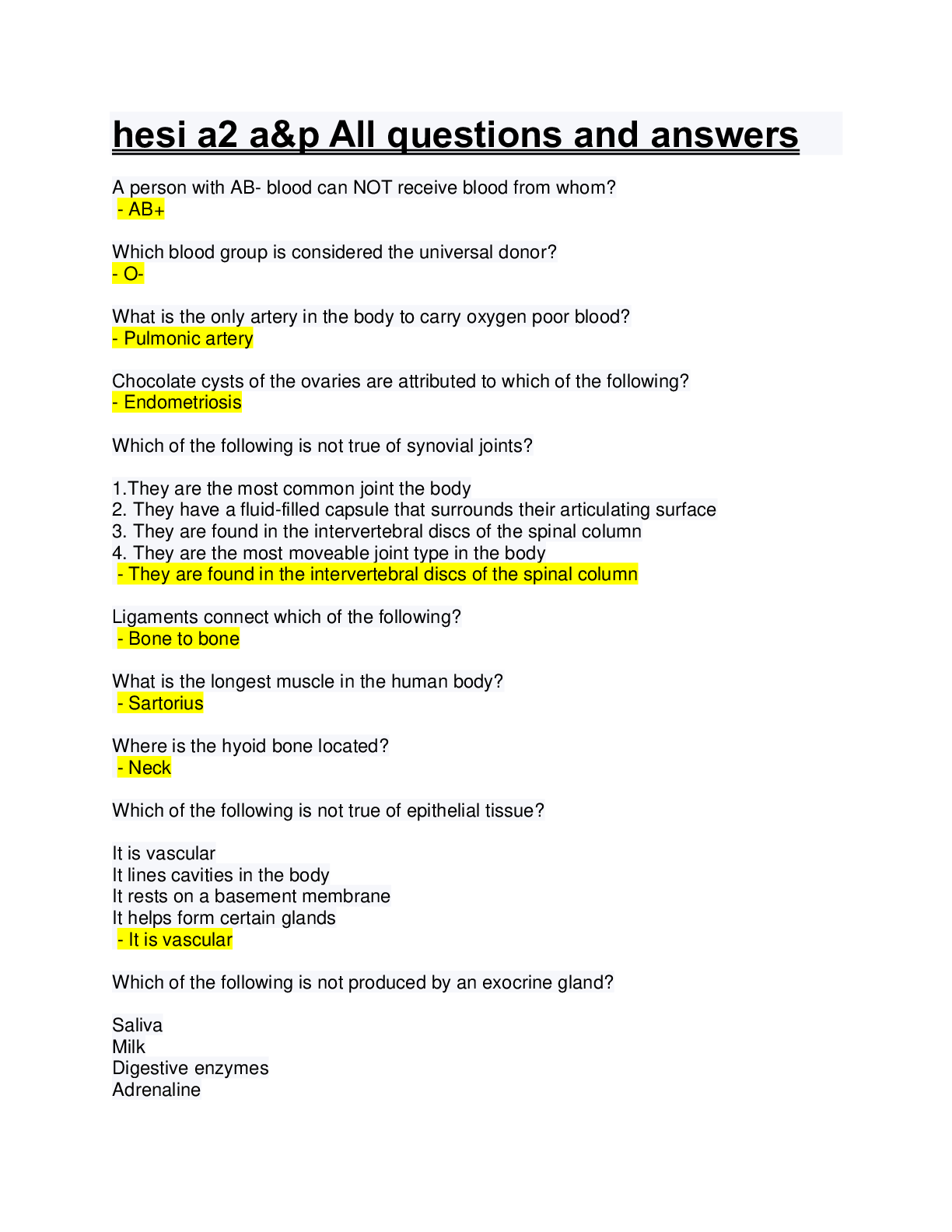
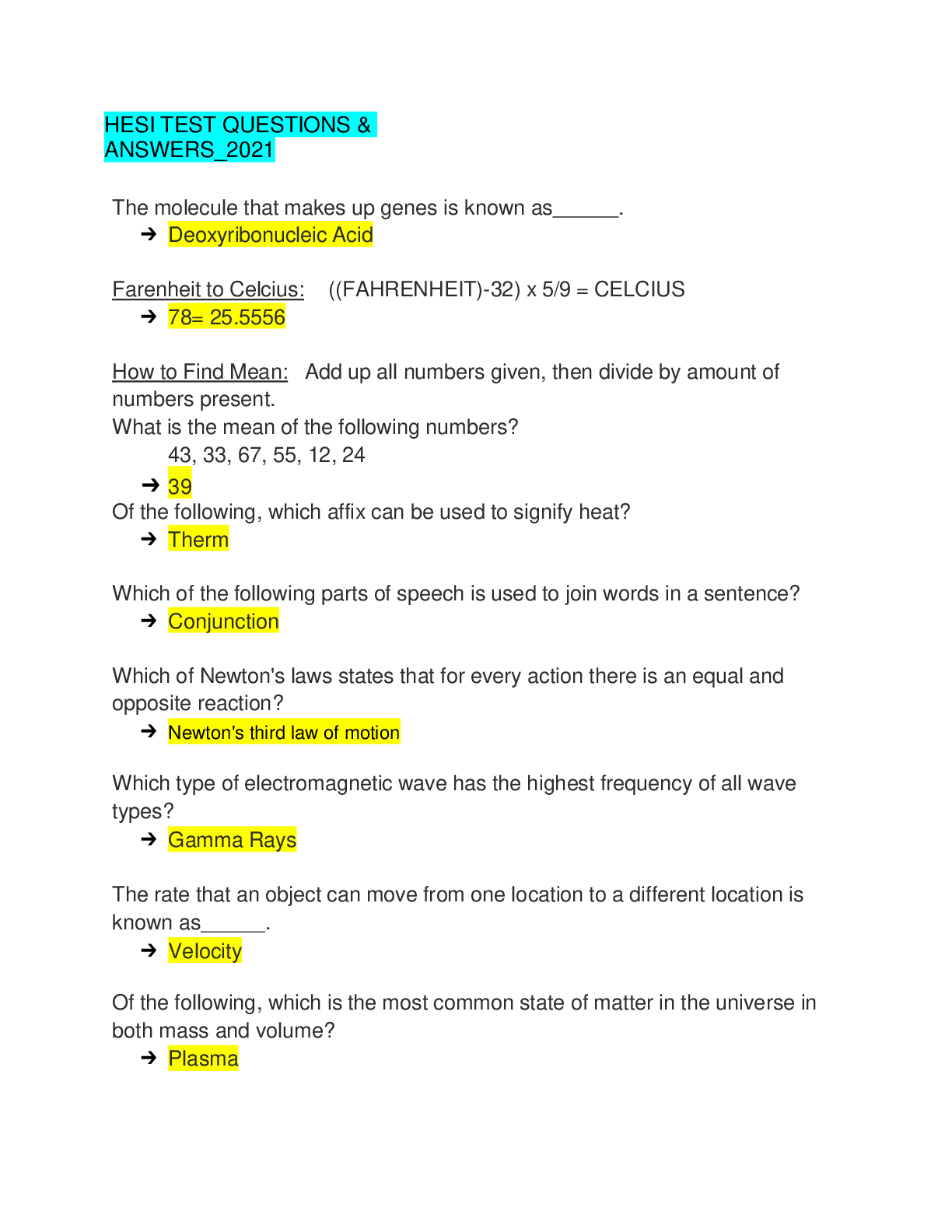
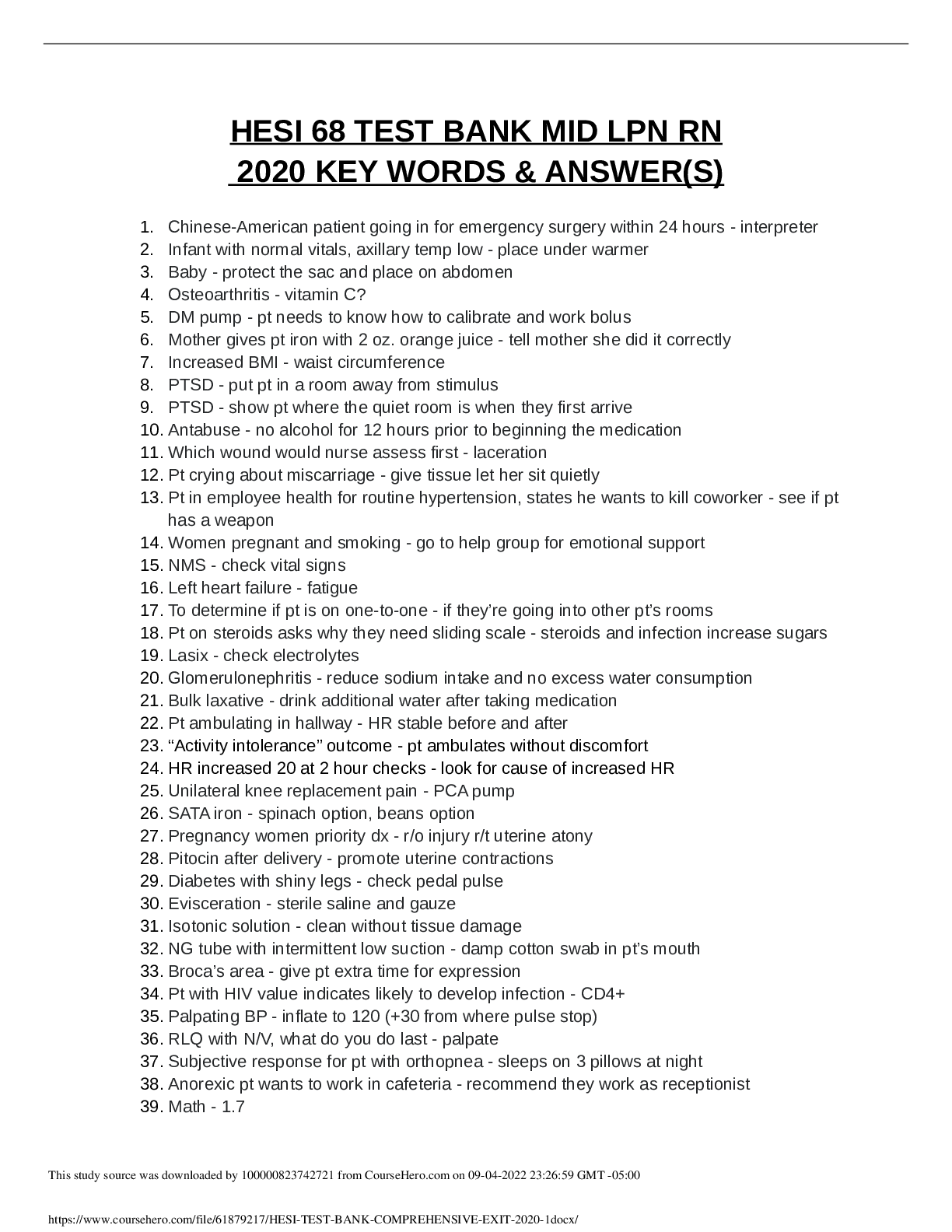
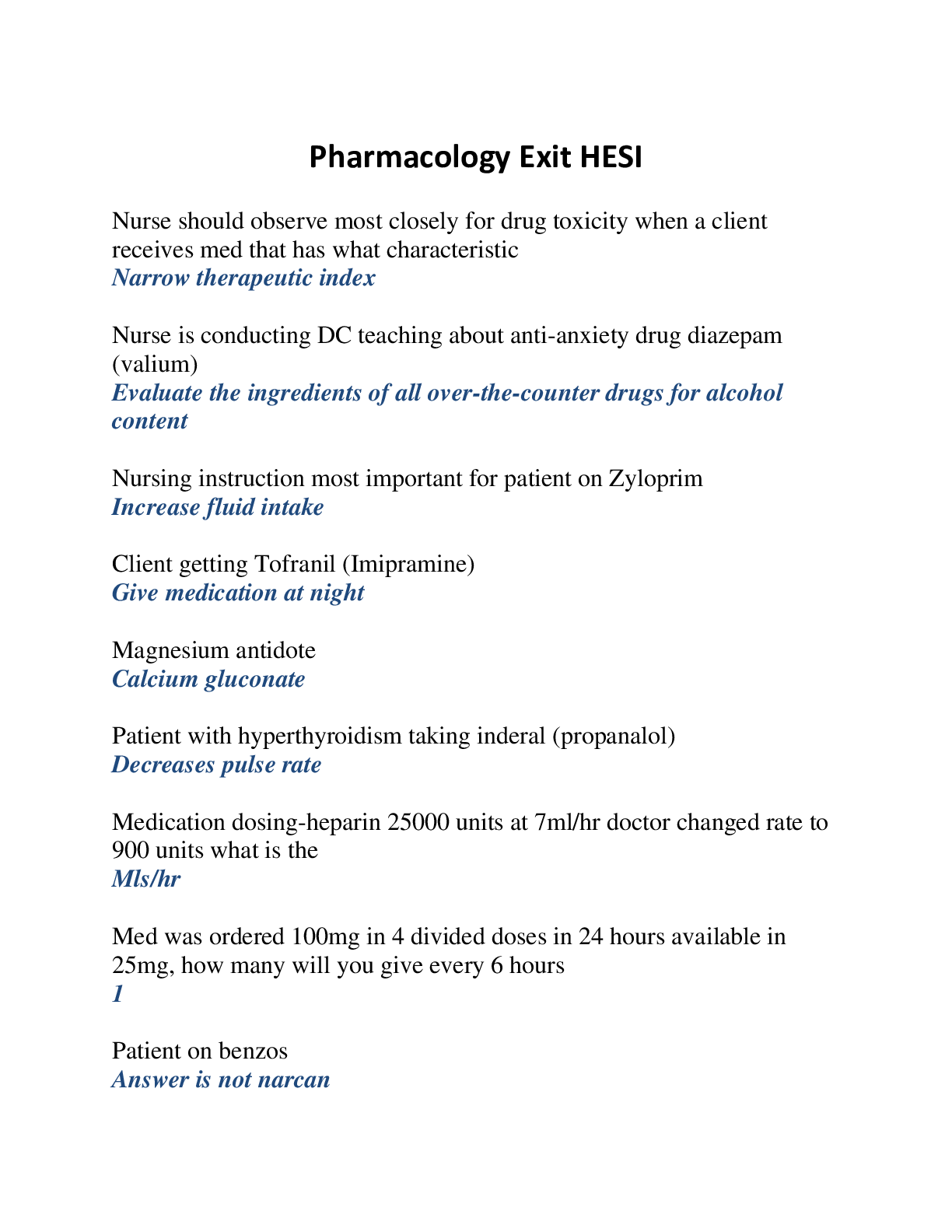
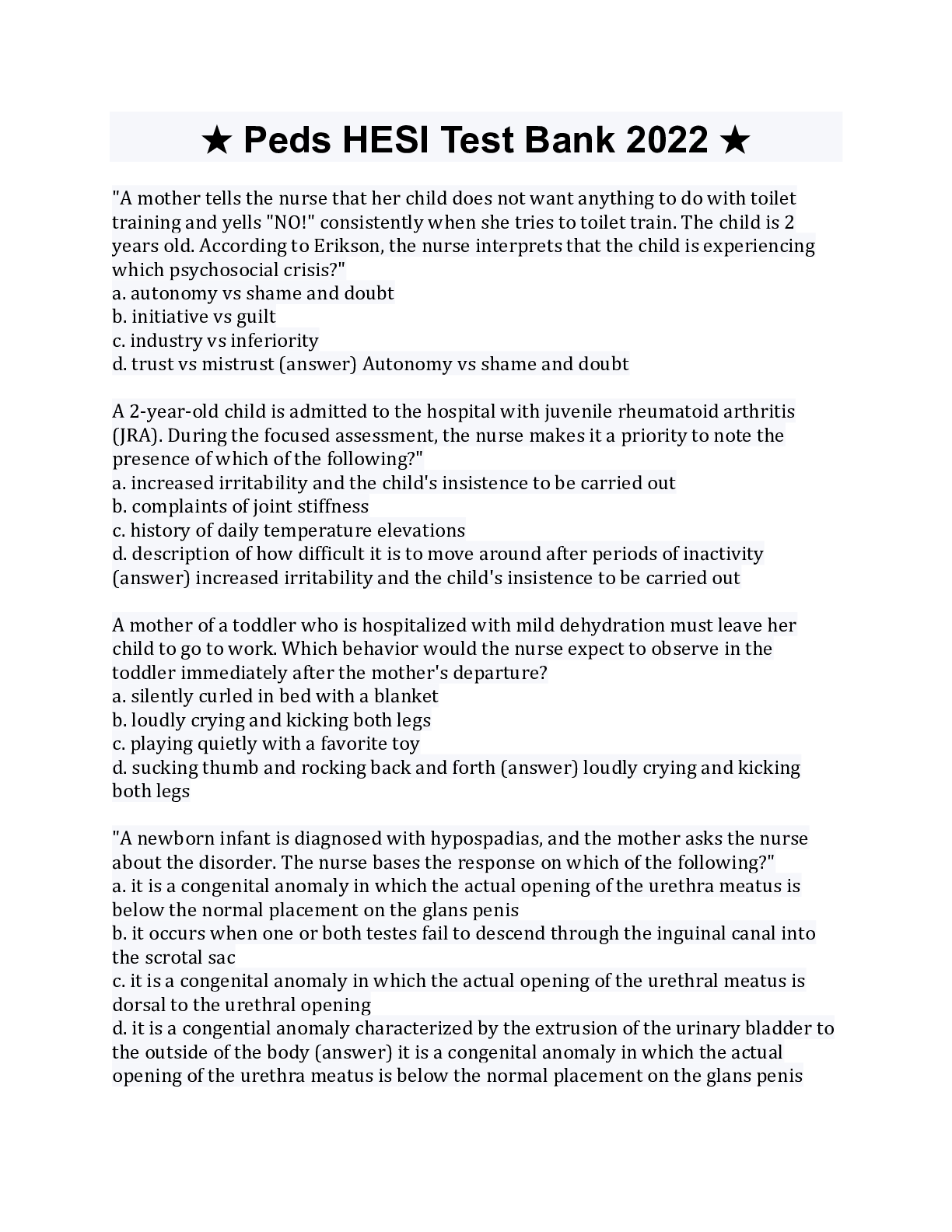
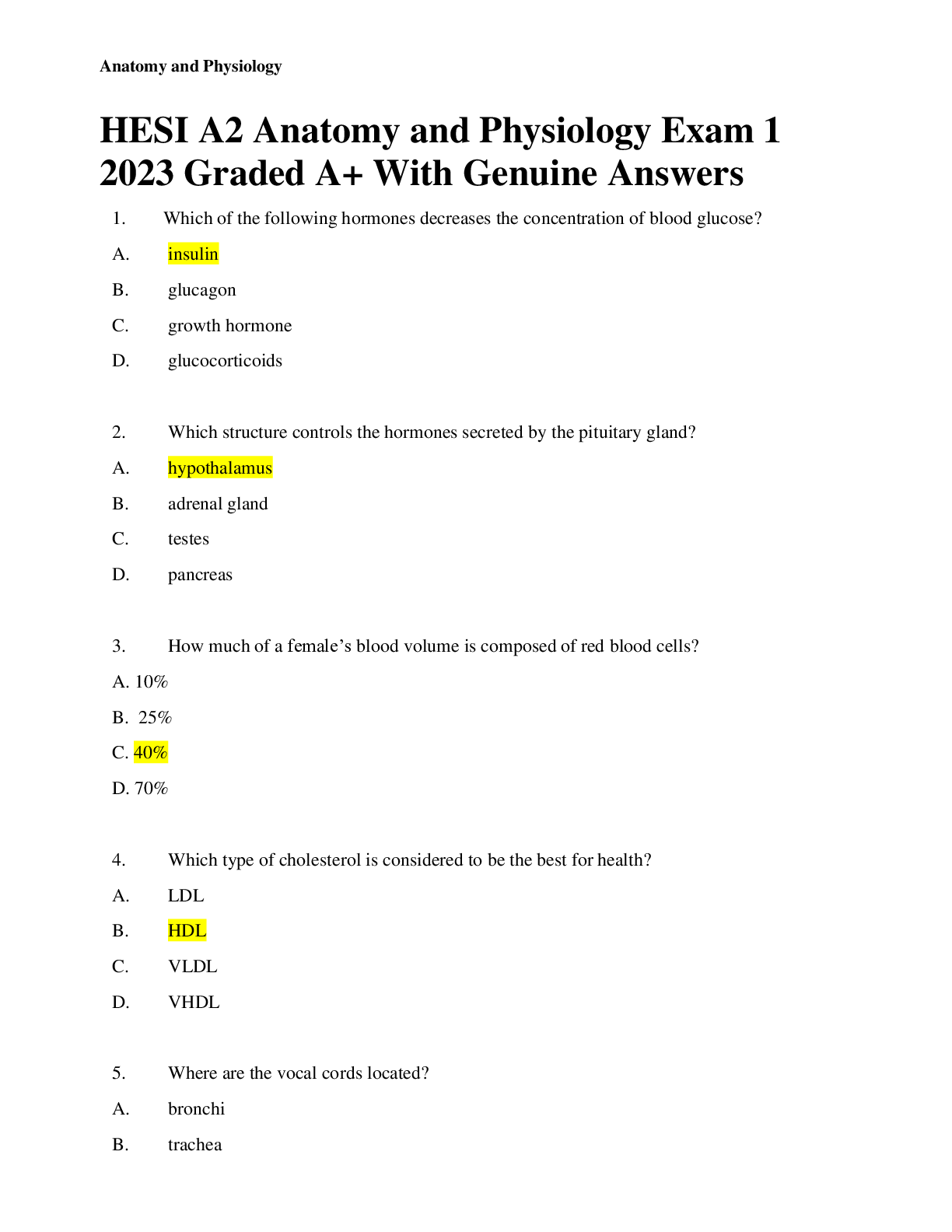
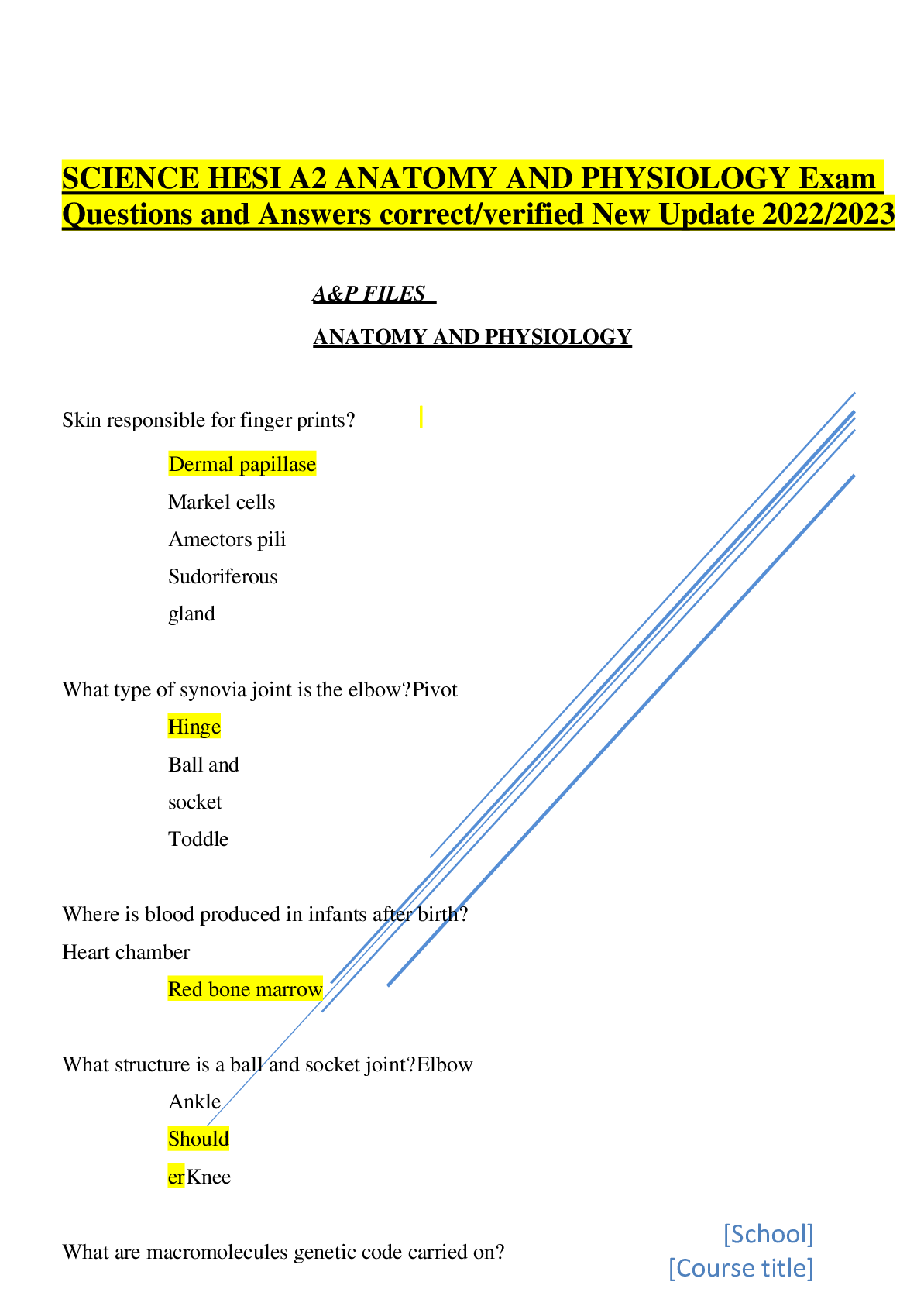
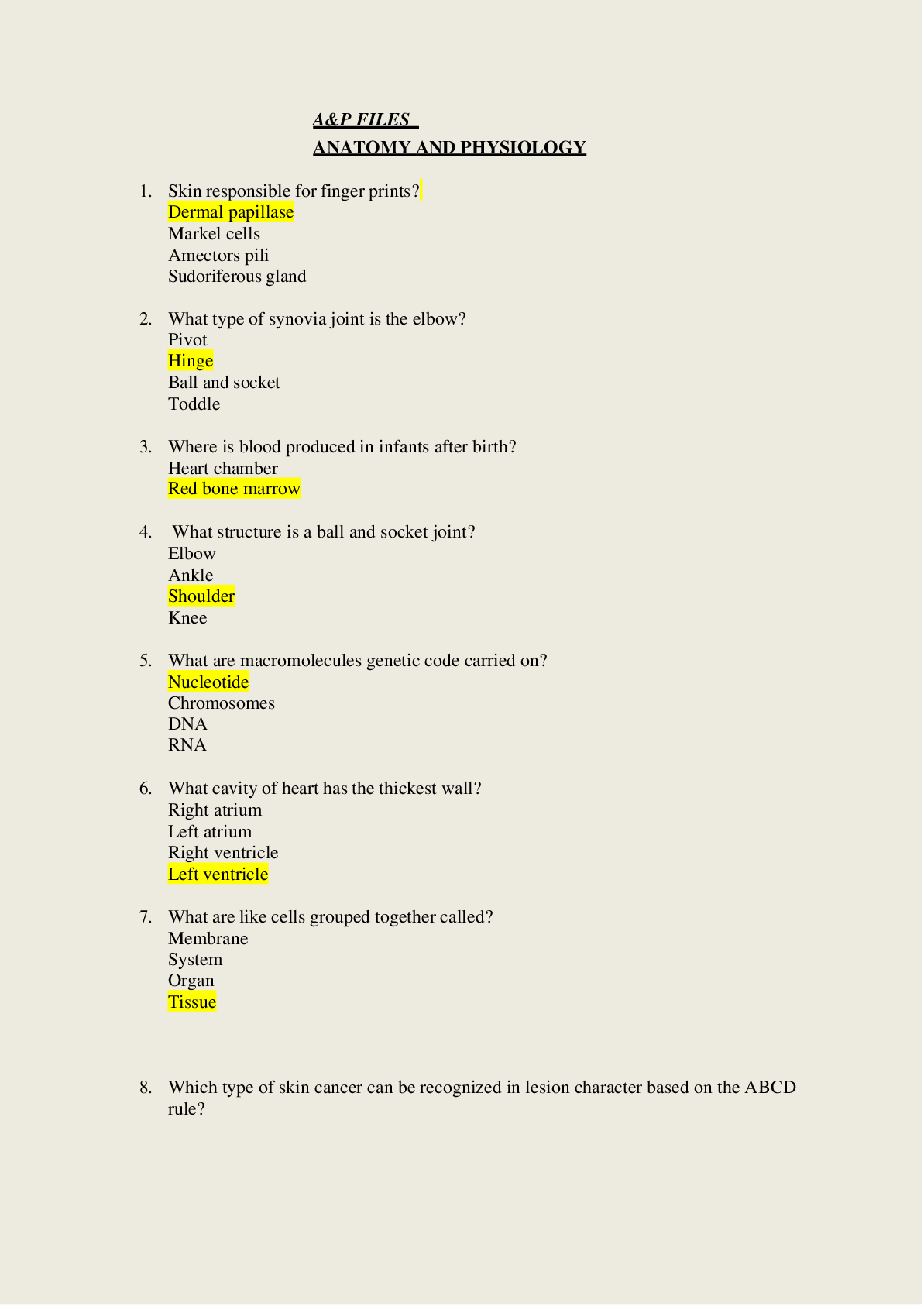
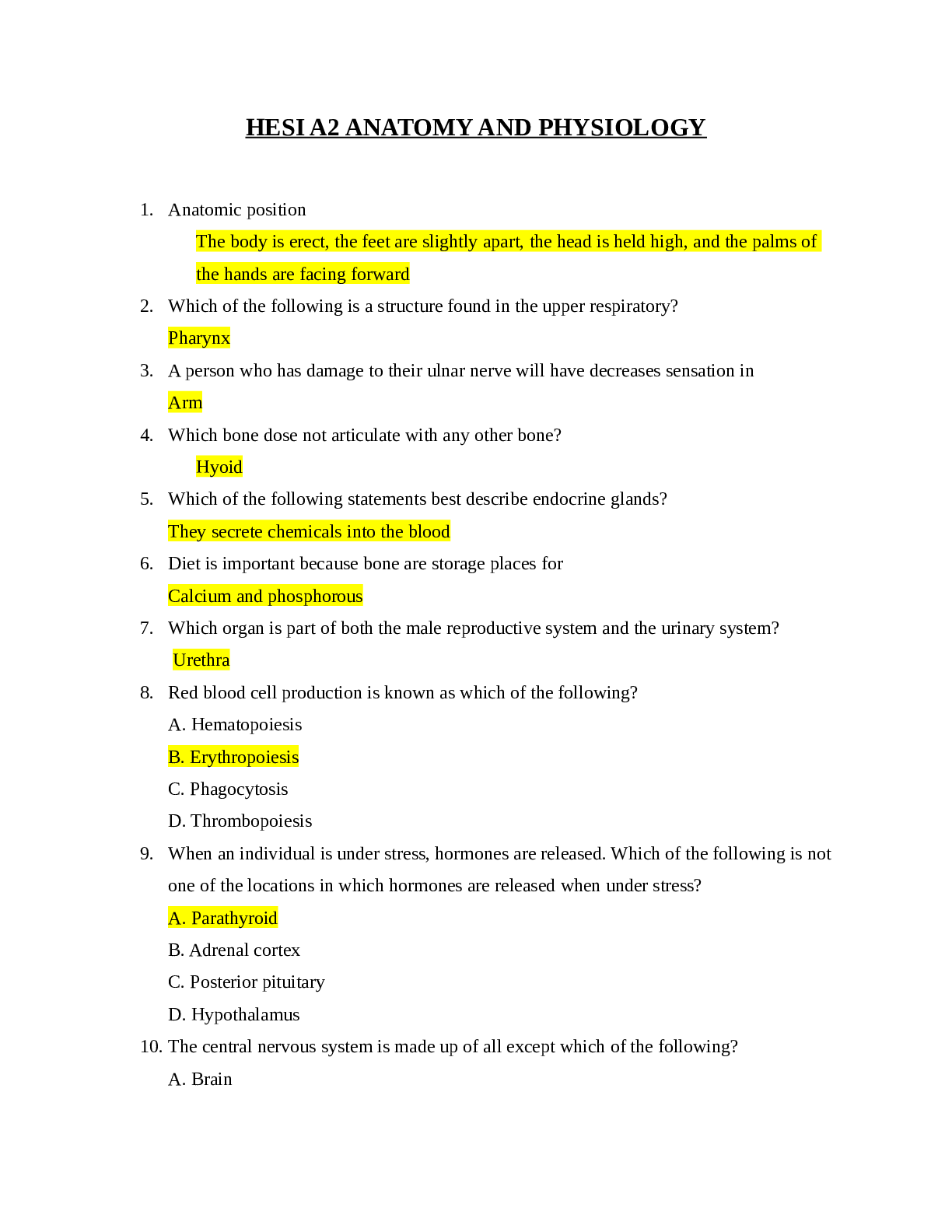
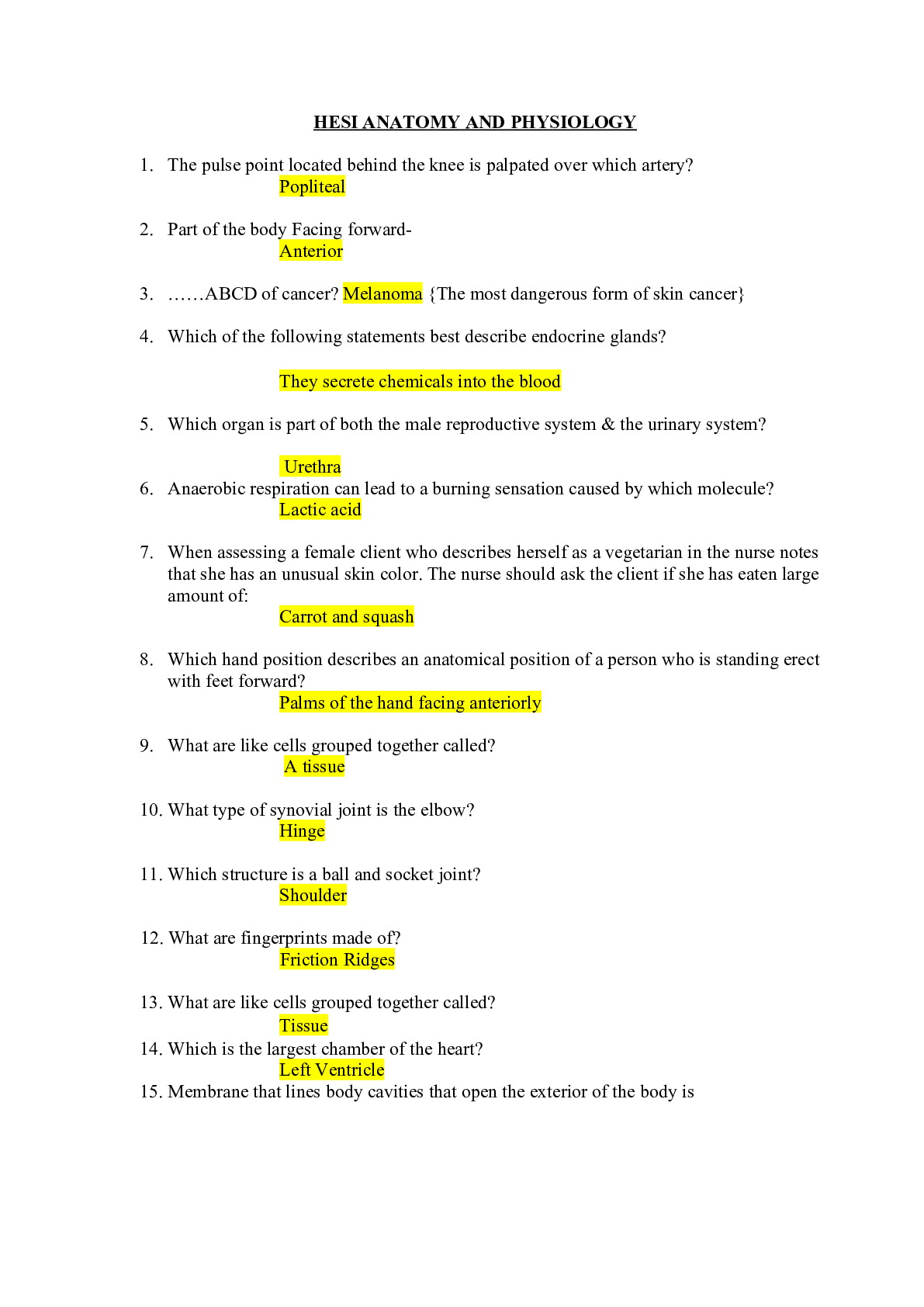
 LATEST QUESTIONS AND COMPLETE SOLUTIONS.png)

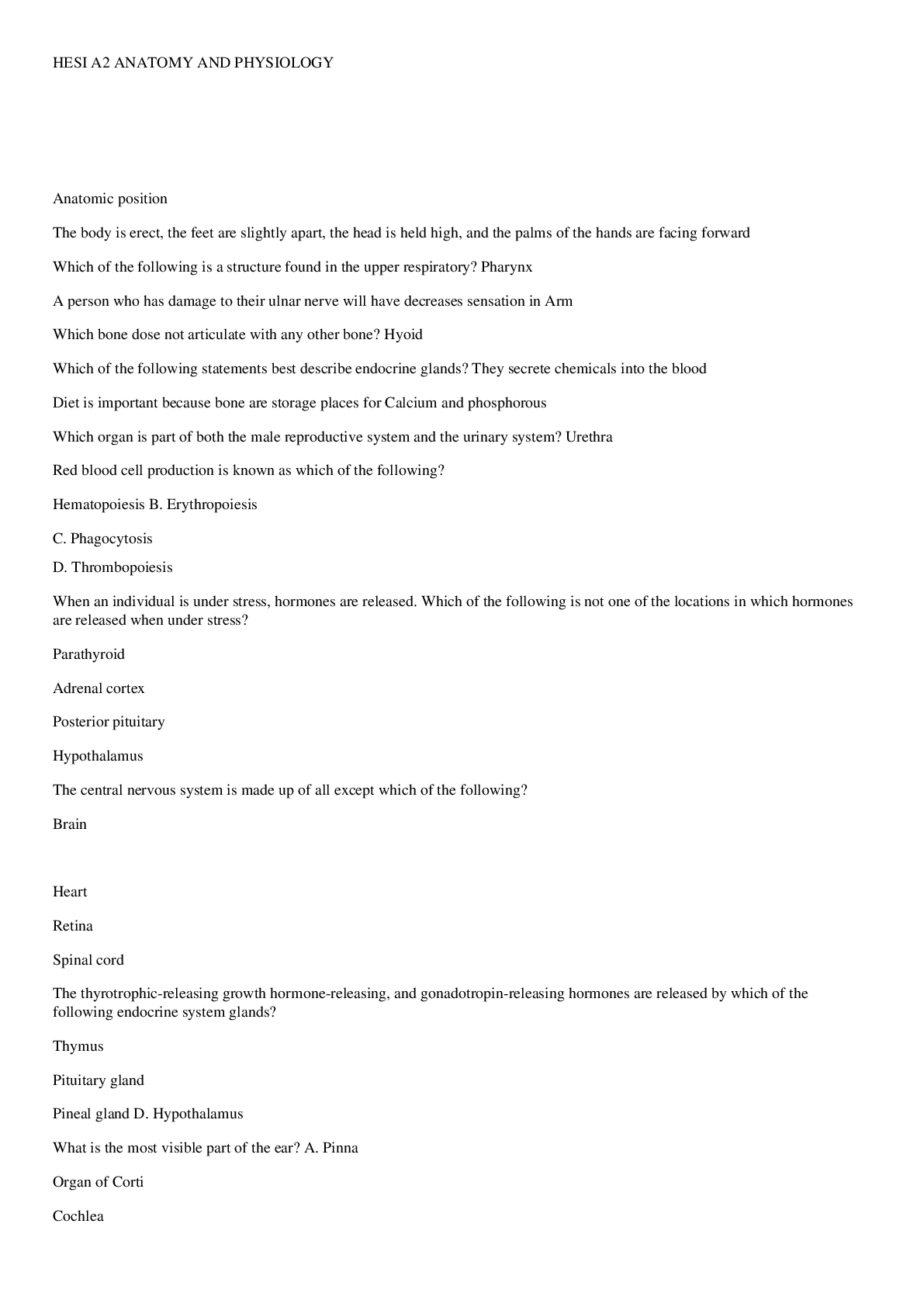
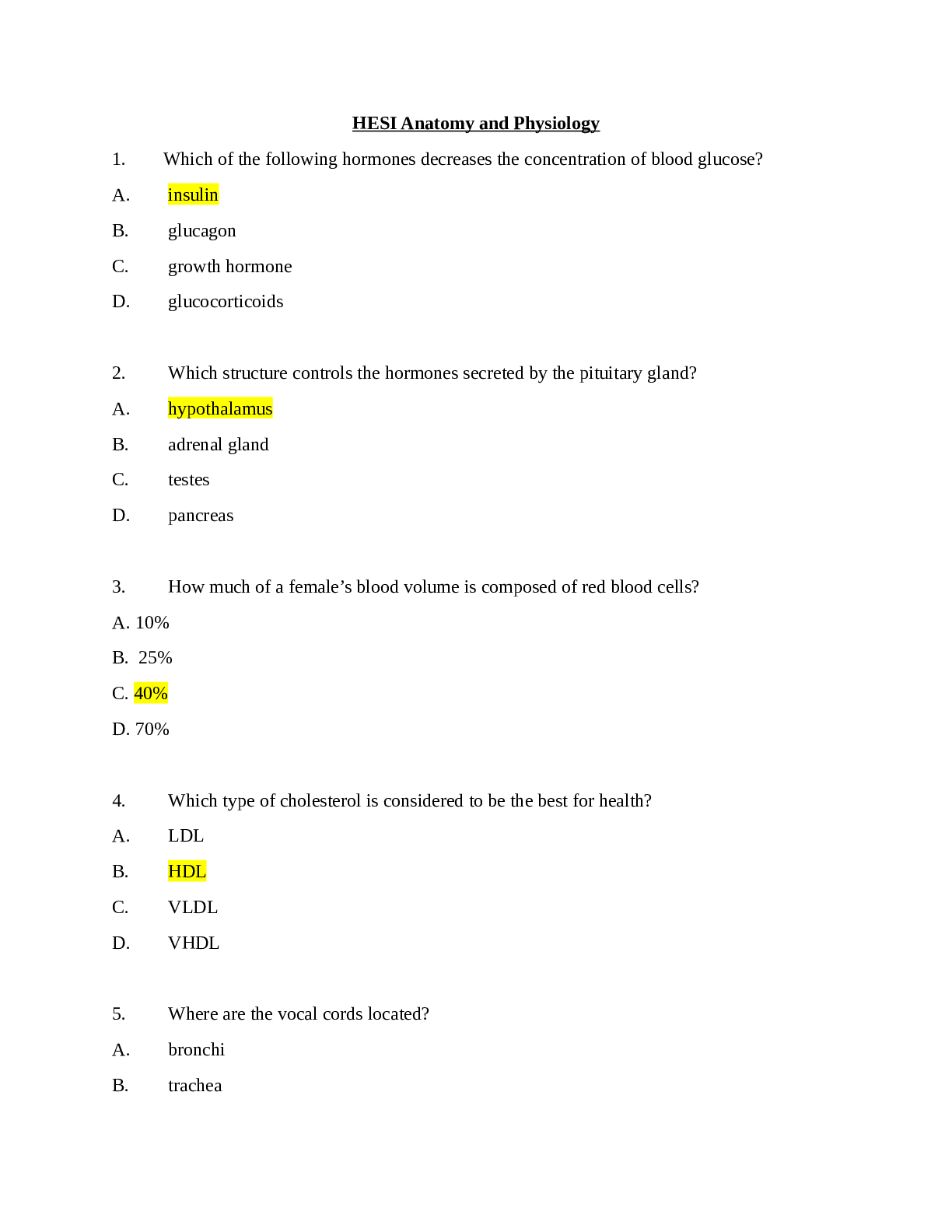
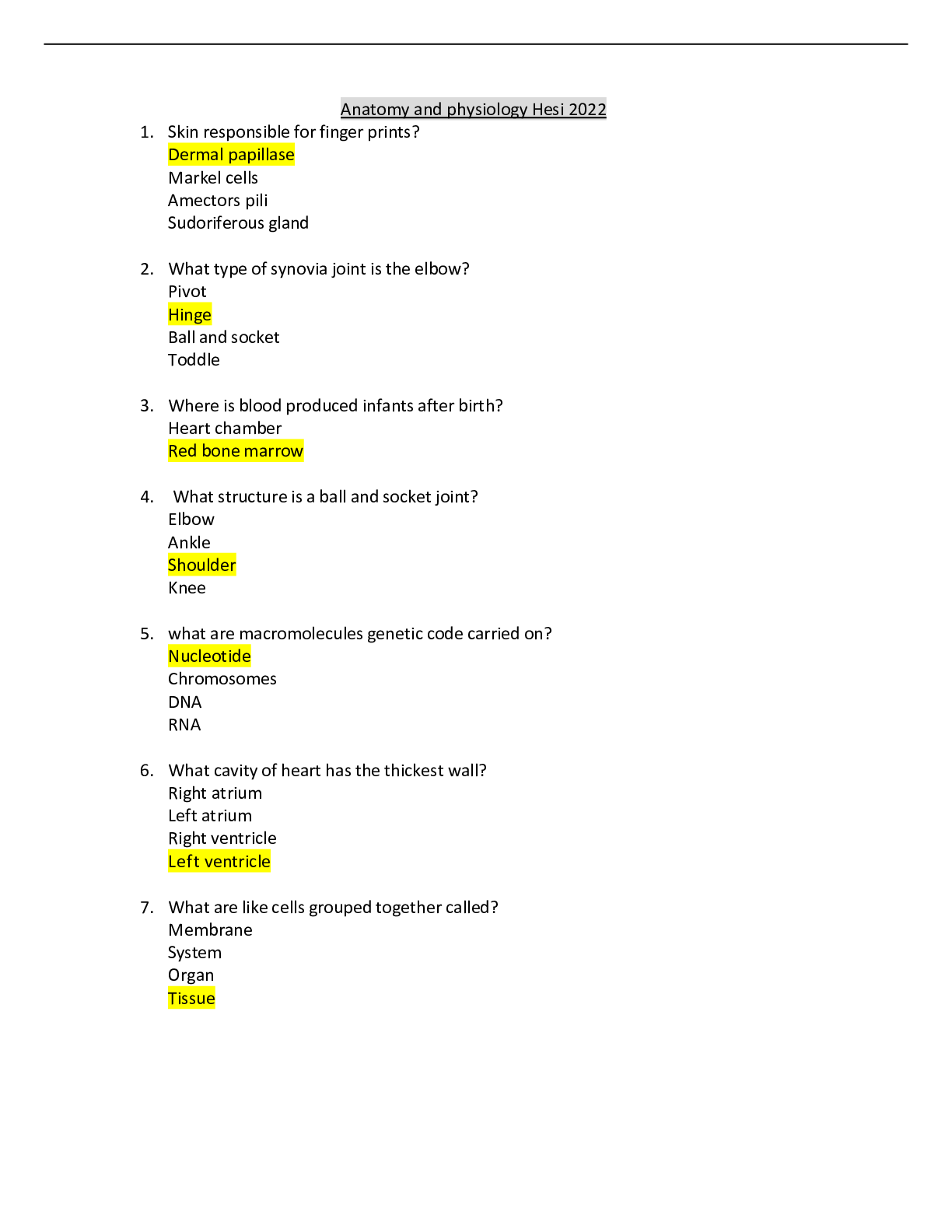

 LATEST GUIDE 2022.png)

.png)
